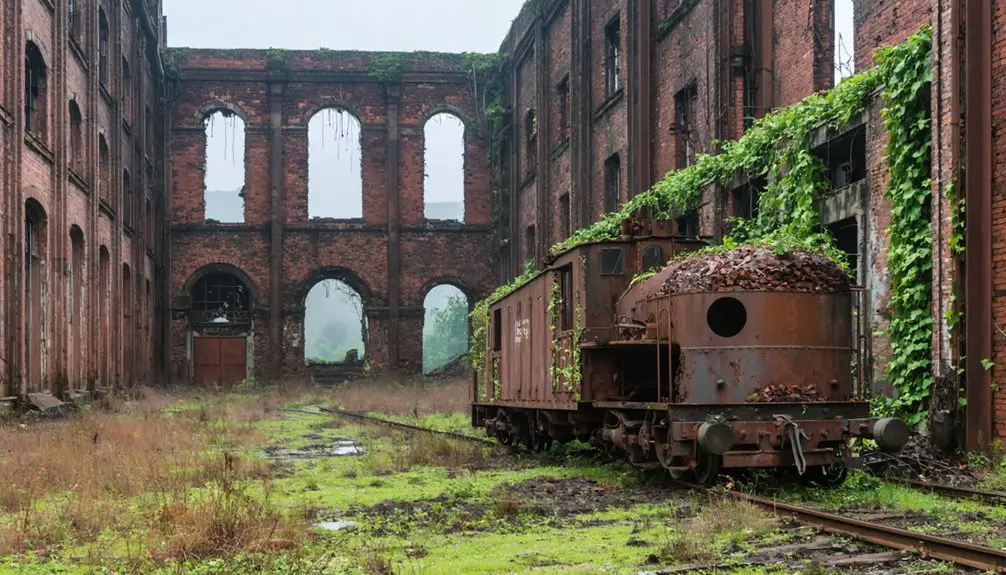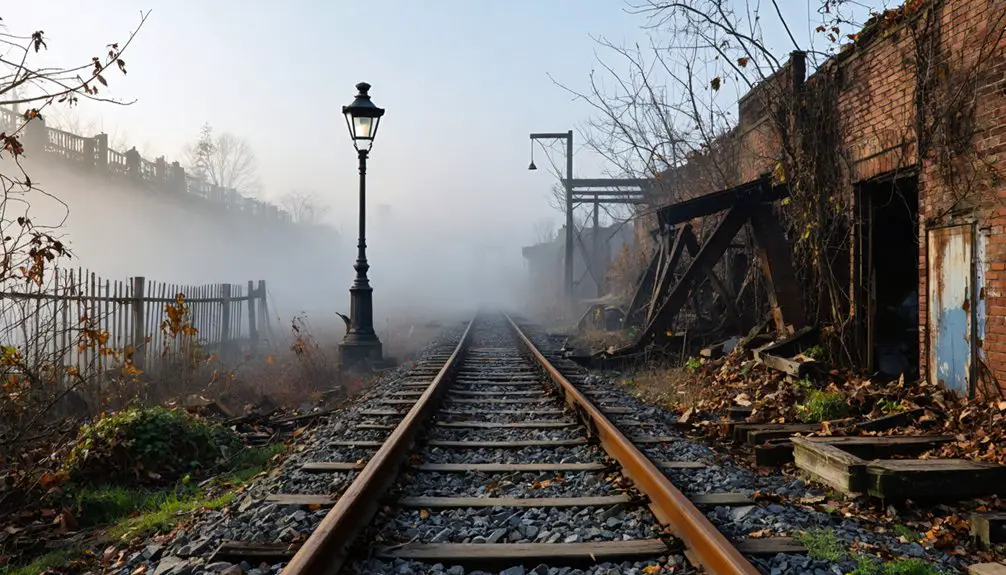You’ll find Lackawanna No. 3 nestled in Pennsylvania’s coal country, established in 1903 by Continental Coal Company. The town thrived as immigrant workers tapped rich anthracite deposits through extensive underground tunnels. Workers lived in company-owned housing while a sophisticated railroad network connected the mines to major markets. Though economic challenges of the 1920s triggered its decline, today you can explore its preserved industrial heritage along Ghost Town Trail, where scattered ruins tell stories of America’s mining past.
Key Takeaways
- Lackawanna No. 3 was established in 1903 by Continental Coal Company as a mining town focused on Pennsylvania’s anthracite coal deposits.
- The community featured company-owned wood-frame houses, shared water wells, and essential mining structures supporting underground operations.
- Poor coal quality after 1904 and economic challenges in the 1920s led to reduced mining operations and eventual abandonment.
- Remnants of the town, including mining structures and railroad infrastructure, can now be explored along the Ghost Town Trail.
- The site preserves Pennsylvania’s mining heritage through interpretive markers and historical society efforts documenting early industrial operations.
The Rise of a Coal Mining Community
As the Industrial Revolution swept across America in the early 20th century, the Continental Coal Company established the Lackawanna No. 3 mine in 1903, tapping into Pennsylvania’s rich anthracite coal deposits.
You’d find an immigrant workforce flocking to the region, drawn by the promise of steady work in the mine’s extensive network of tunnels and shafts that plunged 250-300 feet below ground.
Today, visitors can experience a piece of this history through guided tours that take them 250 feet underground in authentic mine cars.
The community’s resilience emerged through tight-knit social bonds, with men working the mines while women supported the economy through domestic roles and work in local mills.
Shared hardship forged unbreakable community bonds, as families united through mine work, domestic labor, and mill jobs to survive together.
Located in one of the five anthracite counties of Pennsylvania, Lackawanna No. 3 exemplified the region’s dominance in hard coal production.
European immigrants shaped the town’s cultural identity, creating a vibrant community centered around VFW bars and gathering spots, while their children often labored as breaker boys sorting coal under harsh conditions.
Life in the Company Town
Three distinct social classes defined life in Lackawanna No. 3’s company town: management, skilled workers, and laborers.
You’d find these worker communities living in company-owned housing near the mines and mills, where your quality of life largely depended on your position within the social hierarchy.
Daily routines centered around the demanding work schedule, with limited recreational options beyond informal gatherings. The workers faced serious health risks as poor living conditions led to disease outbreaks.
The town’s growth mirrored the rapid industrial expansion that saw the population surge from a few hundred to 35,000 by 1870.
You’d rely heavily on self-organized social and religious activities, as company-provided services were minimal.
If you lived here, you’d experience strict company control over housing, social activities, and even basic utilities.
In these tight-knit worker communities, social dynamics were shaped by immigrant traditions and mutual aid networks, helping families cope with harsh living conditions and economic challenges.
Industrial Operations and Railroad Connection
The bustling industrial operations at Lackawanna No. 3 centered around coal mining and coke production, supporting the massive Lackawanna Steel Company‘s needs after 1900.
Despite challenges with low-quality coal and mining hazards like roof squeezes, the site’s industrial technology remained vital to steel production until its decline in the 1930s. The facility leveraged innovations from earlier operations like the Slocum furnace, which pioneered coal-based smelting methods in the region. Workers faced harsh working conditions as they toiled 300 feet underground in dangerous mining environments.
You’ll find the transportation logistics were impressive for their time. An extensive railroad network, including the Erie Railroad and Delaware & Hudson Railway, connected the mine to major markets.
The company built miles of track and dredged a ship canal to optimize materials handling. As railroads replaced older canal systems, you could see coal moving directly from the mines to industrial centers through a sophisticated network of steam-powered lines and gravity railroads.
Architecture and Infrastructure
You’ll find that Lackawanna No. 3‘s architecture centered on rows of simple wood-frame company houses, built to accommodate the coal miners and their families.
The town’s infrastructure included crucial mining support structures like the company store, while dirt roads connected residential areas to both the mining operations and railroad station. This route became part of the 36-mile trail that visitors explore today.
The railroad station’s layout served as a crucial transportation hub, though like most structures in the town, it has since deteriorated to scattered ruins along today’s Ghost Town Trail. Like other abandoned communities that emerged during the region’s industrial era, Lackawanna No. 3 shared similarities with towns like Wehrum and Claghorn that were deserted after mine closures.
Company Housing Design
Within Lackawanna No. 3’s company housing development, simple functionality defined the architectural approach, with wood-framed row houses and duplexes dominating the residential landscape.
The functional design prioritized durability and economy over ornate details, using locally sourced materials to keep construction costs low. You’d find these homes arranged in efficient grid patterns near the mine entrances, maximizing accessibility for workers. The stark contrast between these simple dwellings and the Tudor Revival style of grander buildings in the region was evident.
Inside each dwelling, you’d discover basic amenities like coal stoves for heating and small front porches.
The architectural simplicity extended to shared facilities, including communal water wells and outdoor privies in earlier structures. While later upgrades brought rudimentary indoor plumbing to some units, the housing maintained its utilitarian character, reflecting the practical needs of mining families rather than aesthetic considerations.
Mining Support Structures
Standing alongside Lackawanna No. 3’s main operations, essential mining support structures formed an intricate network of specialized facilities that enabled coal extraction and processing.
You’ll find timber-framed hoist houses that powered both vertical and inclined hoisting techniques, moving coal from deep underground to the surface. The mine’s sophisticated steam-powered pump system helped control rising water levels in the tunnels. Ventilation systems, including mechanical fans in dedicated buildings, circulated fresh air through the mine’s tunnels while dispersing dangerous gases.
The site featured strategically positioned gravity railbeds along hillsides, where loaded coal cars descended directly to railroad transfer points.
Supporting these operations, you’ll spot maintenance shops, blacksmith facilities, and storehouses that kept the mine running. Steel framing and reinforced concrete eventually replaced original wooden structures, particularly in buildings housing critical hoisting and ventilation equipment.
Railroad Station Layout
As the heart of Lackawanna No. 3’s transportation network, the railroad station complex showcased both architectural grandeur and practical functionality.
You’d find a station built with brick and steel, featuring imported marble interiors and Tiffany glass ceilings that reflected the era’s commitment to luxury travel.
The rail yard configurations included main lines with strategic sidings and branch tracks, allowing seamless connections to industries and other railroads.
Station amenities extended beyond passenger comfort, housing essential support facilities like mechanical departments, fuel storage, and maintenance shops.
You’ll notice how the yard’s layout incorporated engine servicing tracks equipped with sanding towers, fuel racks, and water facilities.
This thorough design guaranteed efficient operations while maintaining the station’s status as a symbol of industrial progress.
Cultural Heritage and Social Life
Like many early 20th-century company towns, Lackawanna No. 3 developed a rich cultural heritage centered around its mining community.
You’d find the town’s social life revolving around key institutions like the company store, community halls, and churches. During your free time, you could attend community events at gathering places where dances and theatrical performances brought residents together.
The town’s cultural traditions reflected its diverse immigrant population, with the Russian Orthodox church serving as a spiritual and social hub for many miners and their families.
Your daily interactions would’ve centered around these communal spaces, from shopping at the company store to attending religious services.
The town’s schools, recreational halls, and social institutions created a structured yet vibrant community life, despite the mining company’s oversight of most activities.
Economic Impact and Peak Years

You’ll find that Lackawanna No. 3’s economic engine roared to life in 1860 when coal mining operations began, requiring extensive valley dewatering and significant capital investment.
The mine’s success drew thousands of workers, primarily men who labored underground while some women found work in local mills and retail establishments.
During its peak years in the late 19th and early 20th centuries, the Lackawanna Iron Works produced massive quantities of railroad iron, contributing to Pennsylvania’s industrial might and creating widespread local prosperity.
Mining Revenue Drives Growth
The Lackawanna Steel Company‘s 1902 reorganization marked a pivotal economic transformation, establishing itself as the world’s largest independent steel producer.
You’ll find their bold $60 million stock issuance fueled unprecedented mining innovation, with $20 million dedicated to constructing a massive new steel mill.
The company’s drive for economic sustainability led to three major developments:
- Construction of a strategic ship canal and railroad network
- Establishment of the Lackawanna Coal & Coke Company to secure fuel supplies
- Creation of a vertically integrated operation controlling 75% of local tax revenue
While the mining operations initially promised prosperity, poor coal quality after 1904 began undermining profitability.
Despite these challenges, the company’s expansive shoreline operations and infrastructure investments transformed the region’s industrial landscape, though ultimately failing to sustain long-term growth.
Employment Creates Local Prosperity
Mining jobs transformed Lackawanna No. 3 into a thriving economic powerhouse during its peak years from the late 1800s through early 1900s.
You’d find worker solidarity evident in the diverse immigrant communities that settled near the mines, building new lives through steady employment. The economic resilience of the region grew as miners’ wages circulated through local businesses, creating opportunities in retail, services, and supporting industries like railroads.
You’ll notice how mining employment didn’t just benefit individual families – it sparked widespread community development. As workers established roots, they fueled the expansion of schools, churches, and housing.
Local government revenues soared from increased economic activity, enabling infrastructure improvements that served the growing population. The prosperity touched every corner of the community, creating a self-sustaining cycle of growth.
The Path to Abandonment
While coal mining thrived in Lackawanna No. 3 during the early 1900s, economic challenges of the 1920s triggered the town’s steady decline. The major abandonment reasons stemmed from the mine’s decreasing profitability and eventual closure, which led to widespread community decline as residents lost their primary source of income.
You can trace the town’s demise through these key developments:
- The 1920s recession halted infrastructure expansion and reduced mining operations.
- By the late 1920s, neighboring mines like Lackawanna No. 4 had already shut down.
- The railroad’s reduced coal transport service further isolated the community.
Without employment options and facing deteriorating company-owned infrastructure, families were forced to leave.
Though some residents continued renting company houses through World War II, the town’s fate was sealed as its economic foundation crumbled.
Ghost Town Trail Legacy

Today, visitors can explore Lackawanna No. 3‘s history along the Ghost Town Trail, a U.S. National Recreation Trail that preserves the legacy of Pennsylvania’s mining heritage.
Step back in time on the Ghost Town Trail, where Pennsylvania’s rich mining legacy comes alive along historic pathways.
You’ll discover interpretive markers explaining the industrial past while following the old Pennsylvania Railroad’s Ebensburg & Blacklick line.
As you trek the trail, you’ll encounter remnants of several ghost towns, including Wehrum’s bank vault and a Russian Orthodox cemetery.
The nearby Eliza Furnace at Vintondale, listed on the National Register, offers a glimpse into early iron production.
Though most structures have vanished and many sites remain on private property, the trail serves as a crucial link to the region’s coal mining culture.
Through preservation efforts and historical markers, you can experience the dramatic story of these once-thriving company towns that shaped Pennsylvania’s industrial era.
Preserving Mining History Today
Through dedicated preservation efforts, Pennsylvania’s rich coal mining heritage continues to thrive in archives, museums, and historical sites across the state.
You’ll find extensive archival preservation happening at the Industrial Archives & Library, established in 2015, where temperature-controlled environments protect essential coal company records.
Community engagement remains strong through:
- Local historical societies collecting photographs and oral histories
- Volunteers maintaining historic sites and leading tours
- Former miners and families participating in educational programs
Digital technology now enables broader access to mining history, with online archives and multimedia presentations reaching new audiences.
The state leads nationally with over 2,300 industrial properties on historic registers, demonstrating Pennsylvania’s commitment to preserving both physical artifacts and cultural legacy of its coal mining past.
Frequently Asked Questions
Are There Any Dangerous Mine Shafts or Sinkholes in Lackawanna No. 3?
You’ll find dangerous abandoned structures at the 108-foot-deep No. 3 shaft, which lacks mine safety measures. While specific sinkholes aren’t documented, the region’s unstable underground tunnels pose collapse risks.
What Happened to the Cemetery Records From Lackawanna No. 3?
Mysterious mining memories: You’ll find these cemetery records largely missing or inaccessible. No formal preservation exists through county resources, diminishing their historical significance for genealogical research. They’re likely lost to time.
Were There Any Major Mining Accidents or Disasters Here?
You’ll find numerous historical accidents recorded in this area, with mining safety issues causing multiple fatalities between 1872-1875, including falls of rock, coal collapses, and equipment-related deaths among immigrant workers.
Can Visitors Legally Collect Artifacts From the Ghost Town Site?
Among crumbling walls and weathered ruins, you can’t legally collect artifacts here. The site’s on private property and protected by preservation laws – removing items risks serious legal ramifications and fines.
What Native American Tribes Originally Inhabited This Area Before Mining Began?
You’ll find the Lenape (Delaware) tribe, particularly the Minsi band, held cultural significance in this area, using it as a migration corridor while other tribes like Susquehannock occasionally passed through.
References
- https://en.wikipedia.org/wiki/Ghost_Town_Trail
- https://kids.kiddle.co/Ghost_Town_Trail
- https://indianacountyparks.org/our-trails/ghost-town-trail/ghost-town-trail-history/
- https://kids.kiddle.co/Wehrum
- https://www.lackawannahistory.org/HistoryBytes/HB_Vol3_No1.pdf
- https://en.wikipedia.org/wiki/Lackawanna_Coal_Mine_Tour
- https://paroute6.com/discover-coal-history-on-pa-route-6/
- https://www.visitnepa.org/things-to-do/attractions/lackawanna-coal-mine-tour/
- https://www.youtube.com/watch?v=6ox-yvTGHqg
- https://en.wikipedia.org/wiki/Lackawanna_Steel_Company



